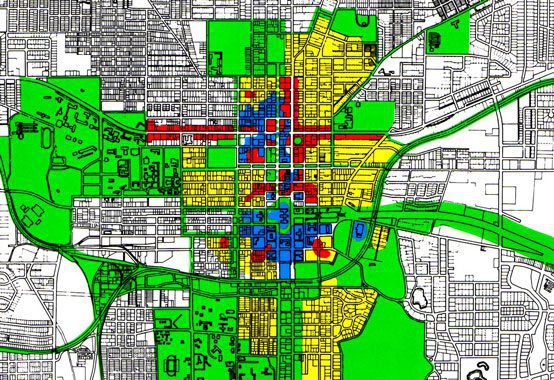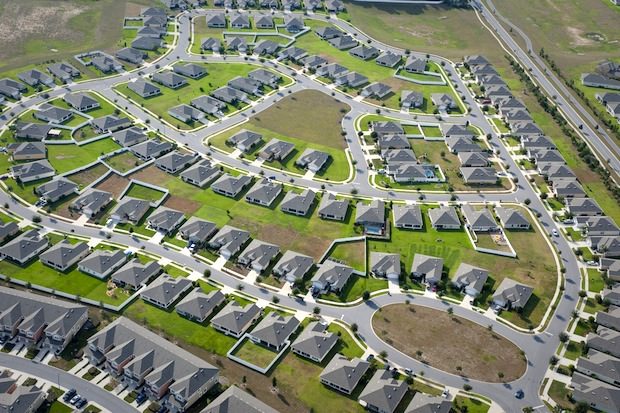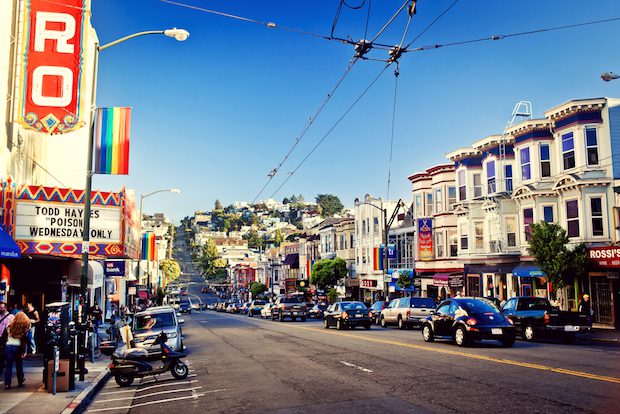Time for a Left-Right Consensus on Zoning Reform

Zoning is having a moment. Across the country, and across the political spectrum, Americans have begun to pay closer attention to the land-use regulations that shape their neighborhoods. And many are fast discovering that some of their most fundamental values are being antagonized by a persistence of antiquated or imprudent rules.
From a political perspective, this presents a unique opportunity: Bad zoning laws threaten some of the deepest values of both of our major political traditions, so the circumstances are ripe for unusual bedfellows. To understand the overlapping nature of those concerns, consider the effects of bad zoning on some of the key priorities of both the conservative and progressive traditions in American politics.
Old But Not Right?
Few principles are more essential to American conservative politics than a belief that citizens should exercise control over privately-owned property with minimal state interference. Since the Supreme Court’s 1926 Euclid decision, however, courts have upheld an expansive view of the police power over land-use matters. Today, outdated laws shaped by dubious mid-20th century urban planning theories, have prohibited sensible building patterns—like Main Streets, with efficiency apartments above stores, and a wide variety of home-based businesses.
Zoning laws were originally written to address the major nuisances of the industrial era— loud, polluting factories and superblocks of overcrowded tenements. Since World War II, however, their mission has crept further away from these salutary objectives to a point where the state—through municipal governments—can now regulate or prohibit almost any use of private property through a simple ordinance. Not only does this stifle individuality; it prevents people from converting their parcels to the highest and best uses the market will support.
During the postwar era—when suburbs and cars were the way of the future, and cheap, undeveloped land surrounded all our cities—the postwar type of zoning seemed a reasonable trade-off for many conservatives. While it regulated the private land market, it was locally enacted. In addition, its intent was to protect a broad base of individual, private owners.
Today, things have changed. Many of our most prosperous regions have been effectively built-out—few undeveloped lots remain—and laws preserve building patterns from the less populous 1950s and 1960s. This in turn has created an artificial shortage of housing units to which local markets cannot respond. Property owners who could benefit from making more intense use of their parcels find their hands tied by local zoning. Families and individuals are priced out of regions where opportunities are strongest. Personal potential and mobility are limited. And local governments become powerful fiefdoms, selectively approving lucrative projects for (often) politically-connected developers while preventing smaller owners from similarly maximizing returns.
Most on the Right also express a strong preference for decisions made close to home. But to work, a decentralized national power structure requires a critical mass of healthy, vibrant communities. Today, small-town America is in deep economic and cultural crisis. Local wealth is drained away by global corporations, and few incentives draw the talent to replace what is lost. Meanwhile, many of our cities are changing so quickly that people cannot recognize, or afford, the places that were once familiar. In short, our communities are failing to respond to rapid change in a way that transmits essential traditions or even offers a sense of continuity. It is particularly salient that, among the casualties of bad zoning are housing options that would allow people to remain in long-term communities, close to family, friends, and self-help groups; as well as affordable retail spaces in which small businesses could begin to rebuild and retain local wealth.
Strong social networks, and their intimate connections to local wealth, are among the most important components of local self-reliance. Such dynamics reduce the need for government support and allow a decentralized power structure to flourish. But a status quo that prices people out of long-term communities attenuates the ties that facilitate self-reliance.
On their own, the above-mentioned real estate deficits would be troublesome; but they are made much worse by the fact that the types of real estate they represent—apartment housing and Main Street retail space—would otherwise be the building blocks of traditional town centers. Significantly, the basic arrangement of traditional towns and cities represents a cultural tradition that can be traced down to modern times from classical antiquity. After a centuries-long process of trial and error, traditional urbanism represents the physical imprint of a functioning, Western- or European-style community. Its forms facilitate commerce, law, religious practice, artistic tradition, civic pride, and ultimately a sense of belonging. Our communities can only be vibrant when their moving parts work together; and conservatism can only work with a critical mass of vibrant communities.
Since the 1920s, new communities have mostly failed to develop according to traditional forms. Today, a critical mass of Americans no longer lives in communities shaped by centuries of tradition; instead, they have been displaced to communities built on the technocrat’s zoning model. Not coincidentally, alienation, isolation, and cultural illiteracy are reaching crisis levels. Traditional urbanism is a time-proven, effective method that transmits an understanding of behavioral patterns from one generation to the next. Its loss is a significant break in that link. For those on the Right who are concerned about the erosion of culture and tradition, this really matters.

A Middle Class Left for Dead?
On the Left, the stability of the American middle class has lately resurfaced as an immediate concern. Activists tend to focus on union membership, and the public-sector systems that unions helped establish (e.g., unemployment insurance, good public education, and safety net programs) as the institutional pillars of a broad middle class. There is merit to these claims. But along with the booming economy of the postwar era (which made such programs solvent), a key component of the American middle class was access to affordable homeownership—and the opportunity to obtain an equity position in an increasingly financialized society.
During the middle-class heyday between World War II and the early 1970s, homeownership became the fundamental building block of an economic foothold in the United States. It combined affordable housing (allowing savings and consumer spending) with appreciating equity, which provided a source of collateral. The suburbs were the heart of this phenomenon, but their rapid construction also took pressure off existing urban housing markets. As a result, housing in working-class neighborhoods was also relatively affordable during the period.
By the early 1970s, the barriers to entry were rising. The aggregated impact of zoning laws on the cost of housing in a particular region was observed in New Jersey’s constitutional law cases that came to be known as the Mount Laurel decisions. Initially, the effects of exclusionary zoning were felt by low-income residents, including—perniciously—many working-class African-Americans, who found themselves priced out of the growing suburbs just as the wave of civil rights legislation abolished many of the legal hurdles that had previously kept them out.
Two generations later, an increasingly sizable proportion of middle-class households cannot afford to purchase median-priced homes. This is especially so in the most prosperous parts of the country. Recent statistics show that in the highly regulated land markets of the Northeast and California, affordability is dismal. In Los Angeles, a 2017 study found that just 6.6 percent of local homes were affordable to households at that region’s median income. In 2014, the figure for the five boroughs of New York City was below 9 percent. For those on the Left who want to see a strong middle class, our failure to provide a vibrant market of affordable housing options in affluent regions—and, by extension, an equity position in the market economy—is a serious stumbling block to social mobility.
The specific degree to which zoning-imposed growth restriction has driven the divergence between household incomes and home prices in such regions is a question ripe for multivariate analysis. That it has been a crucial factor is not debatable. And one of the most immediate effects of zoning-based growth restrictions is the displacement of wealth into adjacent, poorer neighborhoods. On a local level, gentrification takes place more rapidly, and more chaotically, than it would if individual neighborhoods—particularly, the most desirable ones—had room to absorb growth under their zoning rules. In good times, this pattern has produced a knock-on effect that disrupts communities throughout entire metropolitan regions: affluent newcomers are displaced to historically middle-class neighborhoods; middle-class newcomers are displaced to historically working-class and poor neighborhoods; and the working-class and poor are either forced to accept crowded living conditions, or to abandon the region entirely.
On the surface, this gentrification pattern has yielded a number of positive effects, including the revitalization of neglected buildings, windfalls for buyers whose purchase preceded the rise in values and a fleeting economic diversity while neighborhoods are in active flux. But on a deeper level, this pattern has also fed antagonism and competition over scarce space in the places where people have—and fear losing—their most intimate ties. It has turned old neighborhoods into floating commodities. And it has had an especially devastating—and largely unreported—impact on a significant population of working-class and poor Americans of the Northeast and California. Over the last generation, many of the working-class residents of places like New York City, San Francisco, and Boston, especially renters and young people, have been forced to choose between tolerating increasingly substandard living conditions in their home communities, and relocating to distant, unfamiliar places.
This phenomenon may also have played a part in a waxing hostility toward immigration. Consider that a major portion of the white working class that once populated the coastal cities of the Northeast and California has been on the losing end of this phenomenon. Many have watched as their old neighborhoods have been repopulated by immigrants who are willing to pay more for less; long-time residents may even intuit that the newcomers have driven up prices and created a sense of disorientation and loss in a place that had once been safe and familiar. And while older owners have benefited from a rise in property values, other long-time residents have suffered—particularly older renters and young people who wish to remain in the communities where they have grown up. This a terrible price for bad zoning policy; and the irony, from an urban planning perspective, is that even today many of the traditionally working-class neighborhoods of the Northeast and California continue to have low densities.

If local zoning had simply permitted these communities to absorb growth as it occurred, it is likely many longtime residents would never have been priced out by rising rents or property taxes. This means that more young people could have remained in their home communities and benefited from deep ties to family, social networks, and local wealth; and space could also have been made for new immigrants (and internally-migrating Americans) on much friendlier terms. Instead, our inability to accommodate change at the neighborhood level has resulted in the attenuation of countless social ties; the loss of myriad old communities; and an increased degree of hostility and resentment between competing, but similarly powerless groups, over space that never needed to be so scarce. If anything should outrage even the most nominal Leftist, it is a bureaucratic policy that pointlessly pits the American working class against new immigrants over something as fundamental as the need for decent housing.
Finally, while America may be a center-right country, there are abiding, regional exceptions. New England and its Midwestern outposts have formed a cradle of liberalism since the time of the Abolitionists. In the early 20th century, the industrial cities of the Rust Belt gave us labor Leftism. Most recently, the San Francisco Bay, and—to a lesser extent—a constellation of old Eastern college towns and enclaves in New York City have become incubators of the New Left. A pattern emerges: with the exception of the smaller cities of the Rust Belt, the historical geography of the American Left overlaps today with high housing costs and zoning-imposed growth restrictions.
The irony is rich. But as in many social science problems, causation is less important than correlation. Left-of-center Americans who wish to remain in these parts of the country are forced to chase higher incomes. Few things are less consistent with traditional liberal or left-wing priorities than a pursuit of money to the exclusion of other priorities; yet, this is precisely what many of those living in the progressive touchstones of the Northeast and California now do. Ultimately, most on the Left—including many who find themselves caught up in this rat race—would say that Americans should be free to live in whatever city they choose without being required to adopt the values and lifestyles of corporate careerism. Many on the Right would agree. Moreover, these vibrant, historic regions are integral parts of America. Shouldn’t all Americans, regardless of their current wealth or geographic origins, enjoy basic access to the cultural and economic riches of our great cities?
Where Left and Right Meet
Presuming there is space for a consensus, where do we find it? Broadly deregulating the nation’s metropolitan land markets sounds promising, but untenable within the current political landscape. Note, too, that this alone would not bring back the traditions of neighborhood-building that shaped communities until the early 20th century. Instead, due to the loss of tradition and the rise of technology over the past century, it would take us into uncharted territory. Moreover, we will continue to need ways to exclude real nuisances from the neighborhoods where we live and work.
Ultimately, then, the need for reform should focus on the core parts of zoning ordinances that stubbornly prevent salutary change without an overriding and compelling justification. Examples include arbitrary massing requirements, unit counts, and the separation of compatible uses. These approaches must be replaced with regulation that allows developers to meet market demand, with as free a hand as possible, while working within the liberal parameters of traditional urban forms. Such reforms could allow neighborhoods to adjust to the needs of their current residents and businesses; free property owners to pursue the highest and best use of their parcels; and, over time, allow regional housing costs to trend toward equilibrium with local incomes.
Perhaps more importantly, they would allow more Americans, through broader economic empowerment and individual freedom, to shape their communities into reflections of their actual life patterns, cultures, and personalities. This shaping—by rich and poor, urban and rural, liberal and conservative—was once an essential part of what made the United States such an exceptionally democratic society. To a troubling degree, we have lost this quality in recent years—in no small part because of bad zoning.
Theo Mackey Pollack practices law in New Jersey, is a consultant on urban-planning projects, and has worked on Hurricane Sandy recovery projects in New York City. He blogs at Legal Towns, and has also written for the Metro New York Transit-Oriented Development Newsletter and the Steven L. Newman Real Estate Institute’s white papers series.
Follow New Urbs on Twitter for a feed dedicated to TAC’s coverage of cities, urbanism, and place.
Comments